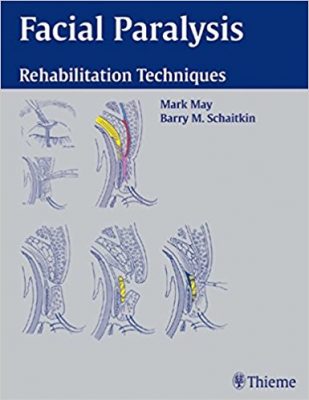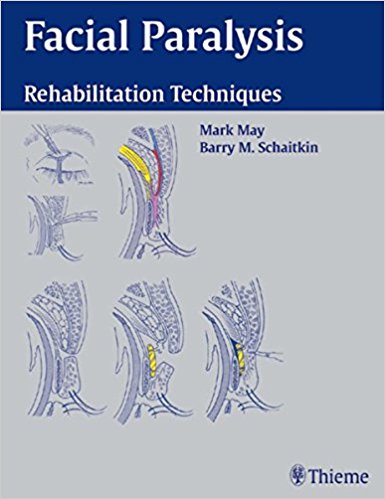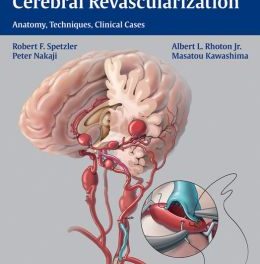 Editors: Mark May, MD; and Barry M. Schaitkin, MD
Editors: Mark May, MD; and Barry M. Schaitkin, MD
Publisher: Thieme – 289 pages, with 1,000+ illustrations
Book Review by: Nano Khilnani
The editors point out that the encyclopedic 885-page-long second edition of The Facial Nerve published in 2000 received high praise from peer reviewers, but practitioners commented that it was “overwhelming” to them due to its length.
There has been great interest in Section VI of that large book dealing with rehabilitation techniques for acute and long-standing facial paralysis. Because of the special interest in that particular Section, the publisher agreed with the editors to reproduce it as a separate volume: this book. It was a good decision because it provides new information not found in other works on surgical corrections in facial paralysis.
The main focus of this book is the surgical rehabilitation of the paralyzed face, with the different aspects of that process shown visually – with charts, drawings, fine-line sketches, micrographs, photos, and tables – and in text form – with discussions within topics and subtopics.
Eight specialists – in facial, general, head and neck, maxillofacial, oculopastic, ophthalmic, oral, plastic, and reconstructive surgery, – and a certified medical illustrator, provided the contents for this book. To give you an overview of what you will find in it, we list the titles of its nine chapters below:
- Perspective in Facial Reanimation
- Nerve Repair
- Nerve Substitution Techniques
- Muscle Transposition Techniques: Temporalis, Masseter, and Digastric
- Free Muscle Transfers for Facial Paralysis
- Eye Reanimation Techniques
- Regional Reanimation: Nose and Mouth
- Reanimation: Dual Systems by Combining Procedures
- Enhancing Facial Appearance with Cosmetic Camouflage
This book is based on extensive surgical experience of the authors and editors, including 30+ years of work by Dr. Mark May, who performed 3,068 procedures on 859 patients.
Here are some aspects of information you will find in this important work on the relatively rare subject of facial paralysis:
- General principles
- Specific techniques
- Step-by-step illustrations
- Patient selection
- Indications
- Contra-indications
- Complications
- Guidelines applicable to specific patient problems
- Non-surgical techniques that can augment surgical efforts by employing cosmetic camouflage
Chapter 1, Perspective in Facial Reanimation, authored by Dr. John Conley and Mark May, is an important one to take a close look at with its main topics, because it provides a good beginning perspective to surgically rehabilitate a paralyzed face. Here are the main components of this chapter:
- Introduction
- Evolution of Facial Reanimation Techniques
- Evaluation of Modern Concepts
- Three Basic Operations for Reanimating the Face
- Factors in Selecting Surgical Technique
- Facial Reanimation: 30 Years’ Experience
- Summary
- References
This is a very well-illustrated book, with before-and-after views of patients who underwent surgery to correct paralysis of various parts of the face and neck, including: cheeks, ears, eyes, forehead, head, lips, mouth, muscles, neck, nose, and multiple features, including an entire region. It provides detailed steps including photo captions on performing the corrective procedures. A great book on a subject on which very few books are available
Editors:
Mark May, MD, FACS is Clinical Professor Emeritus in the Department of Otolaryngology – Head and Neck Surgery at the University of Pittsburgh School of Medicine in Pittsburgh, Pennsylvania.
Barry M. Schaitkin, MD, FACS is Associate Professor in the Department of Otolaryngology – Head and Neck Surgery at the University of Pittsburgh School of Medicine in Pittsburgh, Pennsylvania.
Contributors:
Richard L. Anderson, MD, FACS – Oculoplastic Surgery, Inc., Salt Lake City, UT
John Conley, MD, FACS – Columbia-Presbyterian Medical Center, NY
John P. Coulter, MA, CMI – Facial Paralysis Center, Pittsburgh, PA
Robert E. Levine, MD – University of Southern California, Los Angeles, CA.
Mark May, MD, FACS – University of Pittsburgh School of Medicine, Pittsburgh, PA
Bhupendra C.K. Patel, MD, FRCS, FRC Ophth – University of Utah, Salt Lake City, UT
Barry M. Schaitkin, MD, FACS – University of Pittsburgh School of Medicine, Pittsburgh, PA
William M. Swartz, MD, FACS – University of Pittsburgh School of Medicine, Pittsburgh, PA







